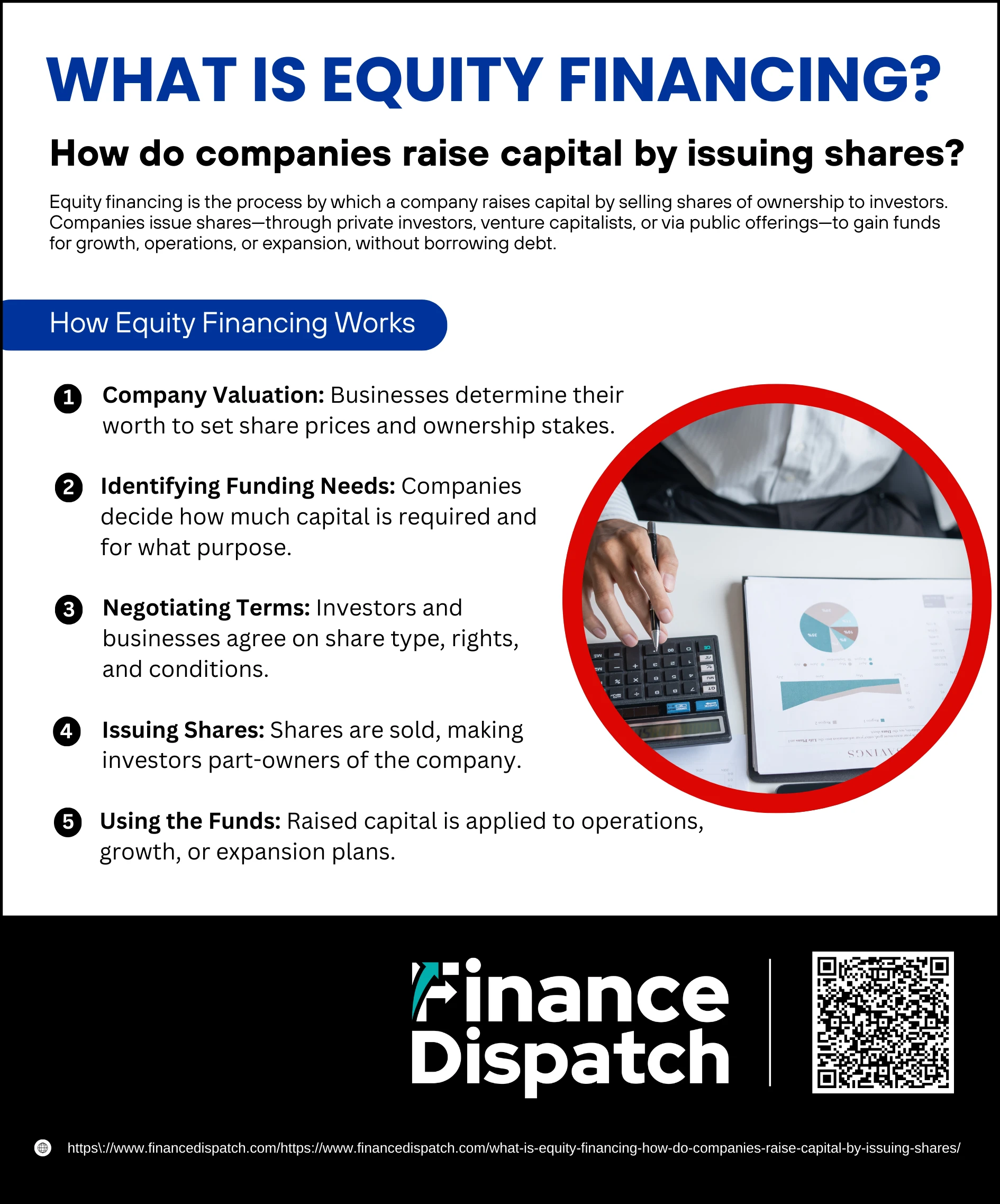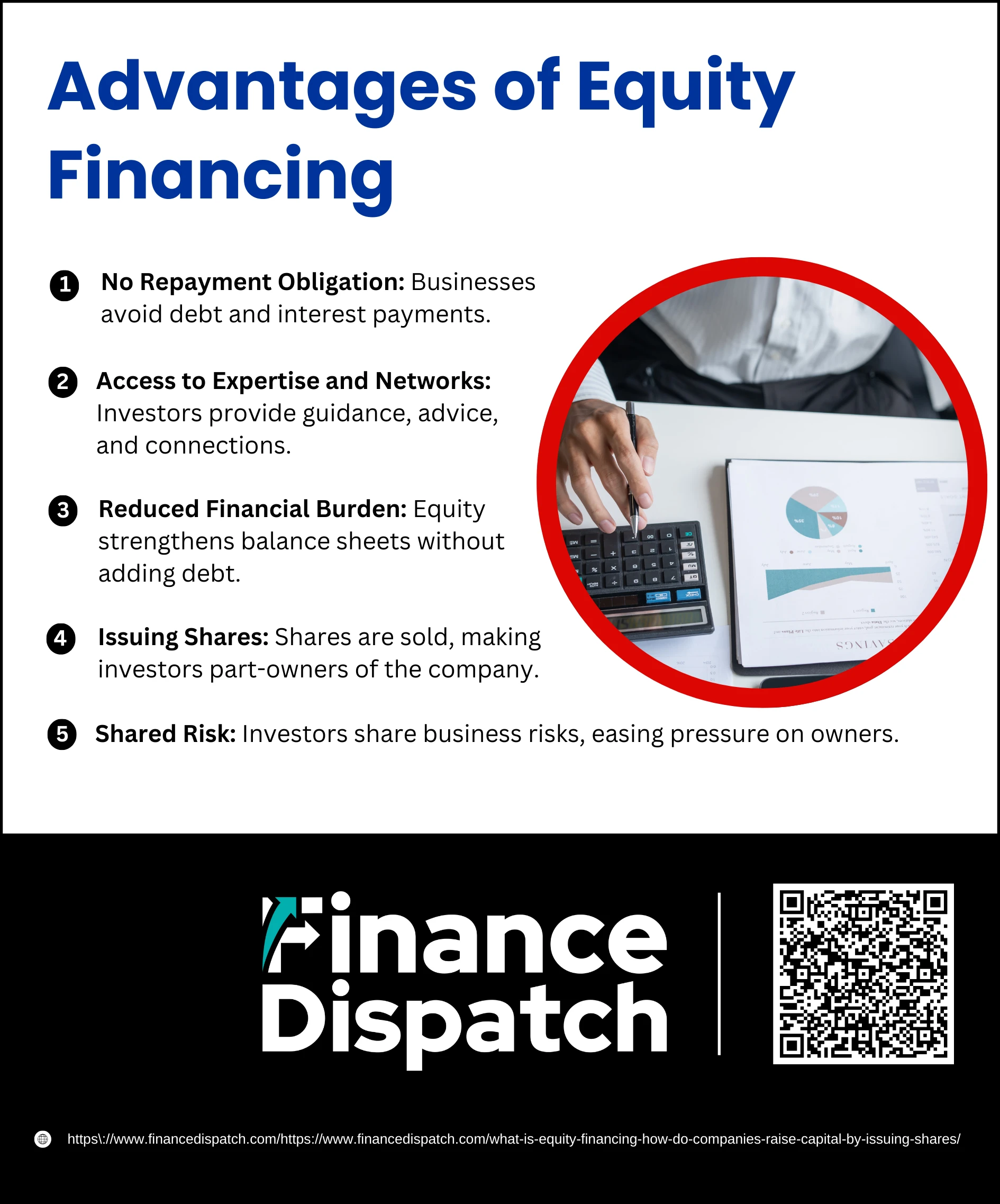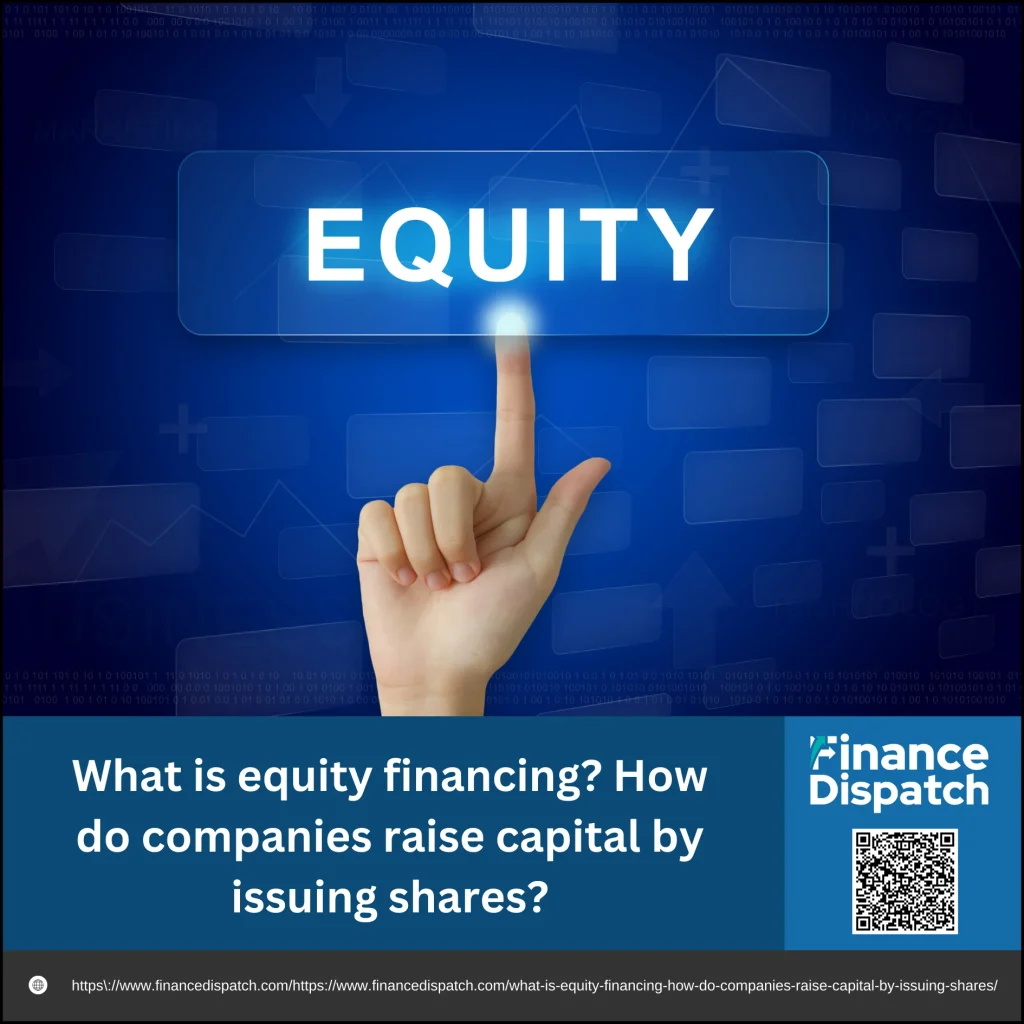Raising money is one of the biggest challenges for any business, whether it’s a small startup trying to launch a new product or a well-established company planning to expand. While loans and other debt options are common, many companies turn to equity financing—selling shares of ownership—to secure the funds they need. Equity financing not only provides businesses with essential capital but also brings in investors who may contribute expertise, networks, and strategic guidance. Understanding how this process works, its benefits and drawbacks, and the various ways companies issue shares is key to seeing why equity financing plays such an important role in modern business growth.
What is Equity Financing?
Equity financing is a way for companies to raise money by selling shares of ownership in their business to investors. Instead of borrowing funds that must be repaid with interest, businesses offer investors a stake in the company, giving them rights to a portion of future profits and, in some cases, influence over major decisions. This method is especially useful for startups that may not qualify for traditional loans, as well as for established companies seeking capital to expand, innovate, or enter new markets. By issuing shares, businesses gain access to essential funding while sharing both the risks and rewards of growth with their investors.
 How Equity Financing Works
How Equity Financing Works
Equity financing allows businesses to exchange ownership for the funds they need to grow. The process typically unfolds in several key stages, ensuring both the company and investors are aligned on value, expectations, and outcomes.
Steps in the Equity Financing Process:
1. Company Valuation
Before offering shares, a business must determine how much it is worth. Valuation takes into account assets, revenue, market potential, and future growth prospects. This step is crucial because it sets the price of shares and defines how much ownership investors will receive in exchange for their capital.
2. Identifying Funding Needs
Companies assess how much money they need and the purpose behind raising it. Some may seek short-term funding to cover operating expenses, while others may raise large sums for long-term goals such as expanding into new markets, developing products, or acquiring other businesses.
3. Negotiating Terms
Once potential investors are identified, both parties negotiate the terms of the investment. This may include the type of shares offered (common or preferred), the ownership percentage, voting rights, dividend policies, and protections for investors. A clear agreement helps avoid conflicts later.
4. Issuing Shares
After terms are finalized, the company issues shares in exchange for cash. Investors now become part-owners of the business. Depending on their stake, some investors remain passive, while others may request active involvement in strategy, operations, or board representation.
5. Using the Funds
Finally, the company puts the raised capital to work. Funds might be used to strengthen day-to-day operations, hire talent, develop new technologies, or finance expansion plans. At the same time, maintaining good investor relations through updates and transparency becomes vital for long-term trust.
Major Sources of Equity Financing
Businesses have several avenues to raise capital by selling shares, and the right source often depends on their stage of growth and funding needs. From wealthy individuals to public markets, each option offers different benefits and trade-offs for both the company and its investors.
Key Sources of Equity Financing:
1. Angel Investors – Wealthy individuals who invest their personal funds in early-stage companies, often bringing expertise, mentorship, and valuable business connections.
2. Venture Capital Firms – Professional investors who provide large sums to high-growth startups in exchange for significant equity stakes and strategic influence.
3. Crowdfunding Platforms – Online platforms where many small investors contribute modest amounts, giving startups a broad investor base and community support.
4. Corporate Investors – Large companies that invest in smaller firms to form strategic partnerships and gain access to new markets, technologies, or innovations.
5. Initial Public Offerings (IPOs) – When a company lists shares on a stock exchange, opening the door to substantial capital from institutional and retail investors.
Equity Financing vs. Debt Financing
When businesses need capital, they often choose between equity financing and debt financing. Both methods provide access to funds but differ in how money is obtained, the risks involved, and the long-term impact on ownership and control. Understanding these differences helps companies decide which option best suits their financial goals and stage of growth.
Comparison Table:
| Aspect | Equity Financing | Debt Financing |
| Ownership | Investors gain a share of ownership in the company | No ownership is given to lenders |
| Repayment | No repayment obligation; investors earn through dividends or capital gains | Requires repayment of principal plus interest |
| Control | Dilution of control, as investors may influence decisions | Founders retain full control of operations |
| Risk | Risk is shared with investors | Business bears full repayment responsibility |
| Cost | Higher cost in the long run due to profit sharing and ownership dilution | Lower cost if interest rates are favorable; payments are predictable |
| Tax Benefit | No tax deduction on dividends | Interest payments are tax-deductible |
| Best Suited For | Startups or firms seeking growth without repayment pressure | Established companies with steady cash flow and ability to handle fixed debt |
 Advantages of Equity Financing
Advantages of Equity Financing
Equity financing gives businesses a powerful alternative to borrowing money. By selling shares, companies gain access to capital while also bringing in partners who can support growth in ways that go beyond cash. Below are some of the main benefits explained in more depth.
Key Advantages of Equity Financing:
1. No Repayment Obligation
Unlike loans, equity financing does not create monthly repayment schedules or interest charges. This gives businesses breathing room to focus on operations and growth instead of worrying about debt obligations. It is especially helpful for startups and young companies that may not have steady cash flow to handle fixed repayments.
2. Access to Expertise and Networks
Investors often bring more than just money. Angel investors and venture capitalists, for example, usually have experience in the industry and can offer mentorship, strategic advice, and valuable business connections. These resources can help a company make better decisions, find new markets, and avoid costly mistakes.
3. Reduced Financial Burden
Because equity financing does not increase debt on the balance sheet, the company’s financial health looks stronger. A low debt-to-equity ratio makes the business more attractive to future investors and lenders. This reduction in financial pressure also means management can reinvest profits into growth rather than servicing debt.
4. Potential for Large Capital
Equity financing opens the door to raising substantial funds, especially when tapping into venture capital firms or going public through an IPO. Unlike loans, which may be capped by collateral or creditworthiness, equity financing can provide access to far larger sums that can fuel expansion, acquisitions, or major innovation projects.
5. Shared Risk
In equity financing, investors share the risks of business growth. If the company struggles or fails, the founders are not required to repay investors, unlike debt financing where repayments are mandatory regardless of performance. This shared responsibility can reduce the personal financial stress on business owners while still giving the company a chance to succeed.
Disadvantages of Equity Financing
While equity financing provides companies with much-needed capital and support, it also comes with trade-offs that can affect ownership, profits, and decision-making. Business owners must carefully weigh these downsides before deciding to give up shares in exchange for funding.
Key Disadvantages of Equity Financing:
1. Loss of Ownership and Control – Selling shares means founders give up a portion of their ownership, and investors may seek influence over major business decisions.
2. Profit Sharing – A part of future earnings must be distributed to shareholders, reducing the portion retained by the original owners.
3. Dilution of Decision-Making Power – With multiple shareholders involved, reaching agreements on strategy and operations can take more time and create conflicts.
4. No Tax Benefits: Unlike debt financing, dividend payments to investors are not tax-deductible, which can increase overall costs.
5. Time-Consuming Process: Negotiating with investors, completing legal documentation, and meeting regulatory requirements can delay access to funds.
Real-World Example of Equity Financing
To better understand how equity financing works in practice, consider the case of a small tech startup seeking funds to expand. The founder initially invests personal savings but soon requires outside capital to scale operations. By bringing in an angel investor, the company gains not only money but also valuable support and guidance.
Example Breakdown:
1. The founder invests $1.5 million of personal capital, owning 100% of the company.
2. An angel investor contributes $500,000 in exchange for equity.
3. The total company value increases to $2 million ($1.5M + $0.5M).
4. The angel investor receives a 25% stake ($500,000 ÷ $2,000,000).
5. The founder’s ownership is reduced to 75%, but the business gains the funds needed for growth.
How Companies Decide Between Debt and Equity
Choosing between debt financing and equity financing is a critical decision that shapes a company’s financial future. Businesses weigh several factors to determine which option aligns best with their goals, growth stage, and appetite for risk. The decision often comes down to balancing control, cost, and access to capital.
Key Factors Companies Consider:
1. Accessibility of Funds – Companies may choose equity if loans are difficult to secure due to limited credit history or lack of collateral.
2. Cash Flow Stability – Firms with steady and predictable cash flow may prefer debt, while those with uncertain income lean toward equity to avoid repayment pressure.
3. Ownership and Control – Founders who want to maintain full control may choose debt, whereas those open to sharing decision-making may opt for equity.
4. Growth Stage of the Business – Startups often rely on equity since they lack the track record for loans, while mature companies with assets can access debt more easily.
5. Cost of Capital – Debt financing includes interest but offers tax benefits, while equity avoids repayments but requires giving up profits and ownership.
6. Long-Term Strategy – Companies planning for rapid expansion may prioritize equity to bring in investors with expertise, while those focusing on stability may favor debt.
Regulation of Equity Financing
Equity financing is closely regulated to protect investors and ensure fair market practices. When companies raise funds by issuing shares, they must comply with rules set by securities authorities such as the U.S. Securities and Exchange Commission (SEC). These regulations govern how shares are offered, the disclosures companies must provide, and the rights of investors. The goal is to prevent fraud, ensure transparency, and maintain trust in the financial markets. Whether through private placements, crowdfunding, or public offerings, businesses are required to follow strict legal frameworks that outline reporting obligations and investor protections.
Conclusion
Equity financing provides businesses with a powerful way to raise capital without taking on debt, making it especially valuable for startups and companies looking to grow quickly. By selling shares, businesses can access not only funds but also expertise, networks, and credibility from investors. At the same time, it requires owners to share profits and decision-making power, which may not suit every business model. Ultimately, the choice between equity and debt—or a mix of both—depends on a company’s financial position, growth goals, and willingness to dilute ownership. When used strategically, equity financing can fuel innovation, expansion, and long-term success.



